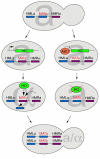RNA asymmetric distribution and daughter/mother differentiation in yeast - PubMed (original) (raw)
Review
RNA asymmetric distribution and daughter/mother differentiation in yeast
Xavier Darzacq et al. Curr Opin Microbiol. 2003 Dec.
Abstract
Active transport and localized translation of the ASH1 mRNA at the bud tip of the budding yeast Saccharomyces cerevisiae is an essential process that is required for the regulation of the mating type switching. ASH1 mRNA localization has been extensively studied over the past few years and the core components of the translocation machinery have been identified. It is composed of four localization elements (zipcodes), within the ASH1 mRNA, and at least three proteins, She1p/Myo4p, She2p and She3p. Whereas the movement of the RNA can be attributed to direct interaction with myosin, the regulation of the RNA expression is less well understood. Recent insights have revealed a role for translation that might have a key function in the regulation of Ash1 protein sorting.
Figures
Figure 1
Mating type switching in the yeast S. cerevisiae. The mating type of a cell is defined by the expression of ‘a’- or ‘α’- specific gene(s) from the active MAT locus. These specific factors are encoded by the transcriptionally silenced HMLa and HMRα loci. Switching to the opposite mating type occurs by gene conversion at the active MAT locus. The template used for this conversion is issued from the silenced HMLa or HMRα locus of the opposite type. HO endonuclease cuts the active MAT locus, initiating this replacement. In daughter cells, the transcriptional repressor Ash1p inhibits the expression of HO, thereby repressing mating type switching (see text for details).
Figure 2
Ash1 mRNA localization. (a) Cartoon of the Ash1 mRNA core locasome transported on an actin filament. E1, E2a, E2b and E3 zipcodes are recognized by the She1–3p complex, providing the motor activity. **(b)**Schematic view of the different steps of ASH1 mRNA bud tip localization (see also Table1). 1 – Nuclear events: ASH1 transcription in late anaphase, association of ASH1 mRNA with She2p, interaction with Loc1p. 2 – Early cytoplasmic events: Assembly of the locasome by association of the newly exported ASH1_mRNA-She2p RNP with She3p and She1p/Myo4p, recruitment to the actin network and interaction with Khd1p and She4p. 3 – Transport of the locasome to the bud tip. She1p/Myo4 provides the motor activity. Role of She4p as a translocation co-factor. 4 – Anchoring and translation at the bud tip: the mechanism of anchoring is still not understood; nevertheless it involves Khd1p and the nascent Ash1p polypeptide. Puf5p and Scp160p are not represented because their role remains largely unknown. (c) Upper image: phase image of a yeast budding cell in early anaphase. Middle image: fluorescent in situ hybridization (FISH) of_ASH1 mRNA using 6 CY3-labeled probes in red and DAPI staining in blue. Lower image: overlay of the two previous images.
Similar articles
- She2p, a novel RNA-binding protein tethers ASH1 mRNA to the Myo4p myosin motor via She3p.
Böhl F, Kruse C, Frank A, Ferring D, Jansen RP. Böhl F, et al. EMBO J. 2000 Oct 16;19(20):5514-24. doi: 10.1093/emboj/19.20.5514. EMBO J. 2000. PMID: 11032818 Free PMC article. - ASH1 mRNA anchoring requires reorganization of the Myo4p-She3p-She2p transport complex.
Gonsalvez GB, Little JL, Long RM. Gonsalvez GB, et al. J Biol Chem. 2004 Oct 29;279(44):46286-94. doi: 10.1074/jbc.M406086200. Epub 2004 Aug 23. J Biol Chem. 2004. PMID: 15328357 - RNA-protein interactions promote asymmetric sorting of the ASH1 mRNA ribonucleoprotein complex.
Gonsalvez GB, Lehmann KA, Ho DK, Stanitsa ES, Williamson JR, Long RM. Gonsalvez GB, et al. RNA. 2003 Nov;9(11):1383-99. doi: 10.1261/rna.5120803. RNA. 2003. PMID: 14561888 Free PMC article. - RNA localization in yeast: moving towards a mechanism.
Gonsalvez GB, Urbinati CR, Long RM. Gonsalvez GB, et al. Biol Cell. 2005 Jan;97(1):75-86. doi: 10.1042/BC20040066. Biol Cell. 2005. PMID: 15601259 Review. - Local regulation of mRNA translation: new insights from the bud.
Paquin N, Chartrand P. Paquin N, et al. Trends Cell Biol. 2008 Mar;18(3):105-11. doi: 10.1016/j.tcb.2007.12.004. Epub 2008 Feb 8. Trends Cell Biol. 2008. PMID: 18262421 Review.
Cited by
- She3p possesses a novel activity required for ASH1 mRNA localization in Saccharomyces cerevisiae.
Landers SM, Gallas MR, Little J, Long RM. Landers SM, et al. Eukaryot Cell. 2009 Jul;8(7):1072-83. doi: 10.1128/EC.00084-09. Epub 2009 May 8. Eukaryot Cell. 2009. PMID: 19429778 Free PMC article. - Translation of ASH1 mRNA is repressed by Puf6p-Fun12p/eIF5B interaction and released by CK2 phosphorylation.
Deng Y, Singer RH, Gu W. Deng Y, et al. Genes Dev. 2008 Apr 15;22(8):1037-50. doi: 10.1101/gad.1611308. Genes Dev. 2008. PMID: 18413716 Free PMC article. - The functional organization of axonal mRNA transport and translation.
Dalla Costa I, Buchanan CN, Zdradzinski MD, Sahoo PK, Smith TP, Thames E, Kar AN, Twiss JL. Dalla Costa I, et al. Nat Rev Neurosci. 2021 Feb;22(2):77-91. doi: 10.1038/s41583-020-00407-7. Epub 2020 Dec 7. Nat Rev Neurosci. 2021. PMID: 33288912 Free PMC article. Review. - Organelle segregation during mitosis: lessons from asymmetrically dividing cells.
Ouellet J, Barral Y. Ouellet J, et al. J Cell Biol. 2012 Feb 6;196(3):305-13. doi: 10.1083/jcb.201102078. J Cell Biol. 2012. PMID: 22312002 Free PMC article. Review. - Regulation of asymmetric stem cell division: spindle orientation and the centrosome.
Yamashita YM. Yamashita YM. Front Biosci (Landmark Ed). 2009 Jan 1;14(8):3003-11. doi: 10.2741/3430. Front Biosci (Landmark Ed). 2009. PMID: 19273252 Free PMC article. Review.
References
- Kloc M, Zearfoss NR, Etkin LD. Mechanisms of subcellular mRNA localization. Cell. 2002;108:533–544. - PubMed
- lathman V, Singer RH. Handbook of Cell Signaling. Vol. 3. (USA) ES; 2003. RNA localization and signal transduction; pp. 293–297.
- Sil A, Herskowitz I. Identification of asymmetrically localized determinant, Ash1p, required for lineage-specific transcription of the yeast HO gene. Cell. 1996;84:711–722. - PubMed
- Bobola N, Jansen RP, Shin TH, Nasmyth K. Asymmetric accumulation of Ash1p in post anaphase nuclei depends on a myosin and restricts yeast mating-type switching to mother cells. Cell. 1996;84:699–709. - PubMed
- Haber JE. Mating-type gene switching in Saccharomyces cerevisiae. Annu. Rev. Genet. 1998;32:561–599. - PubMed
Publication types
MeSH terms
Substances
LinkOut - more resources
Full Text Sources
Molecular Biology Databases
Miscellaneous

